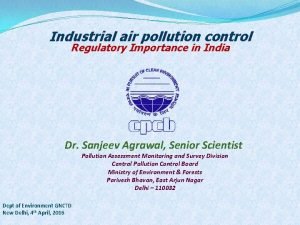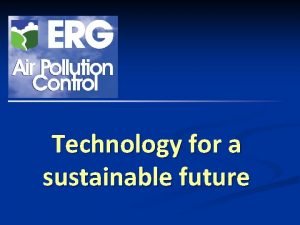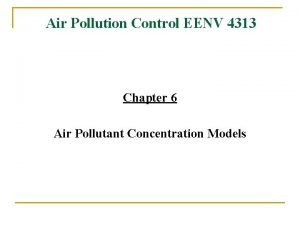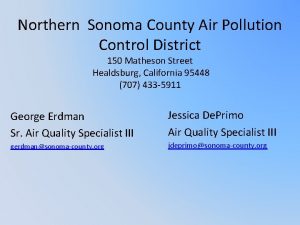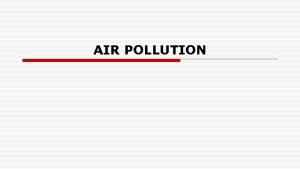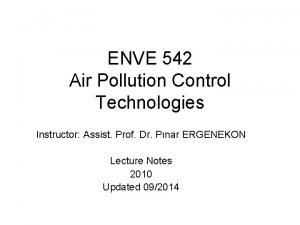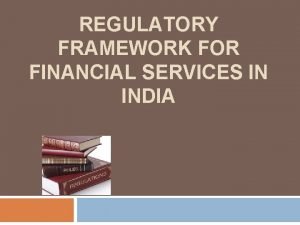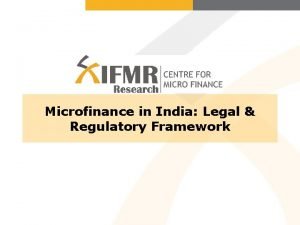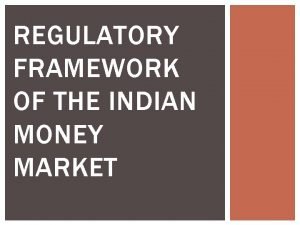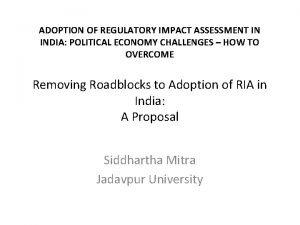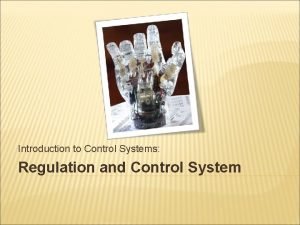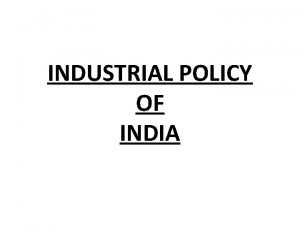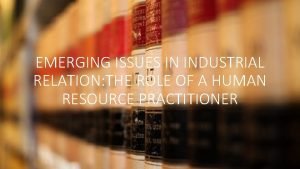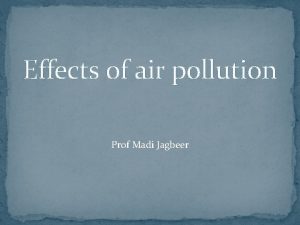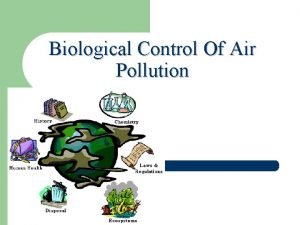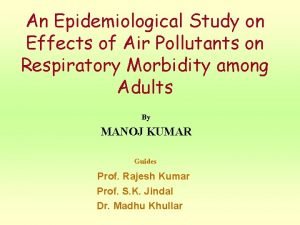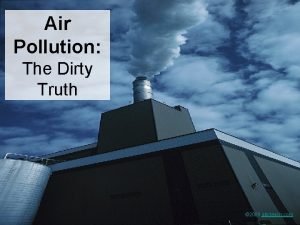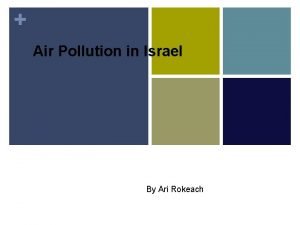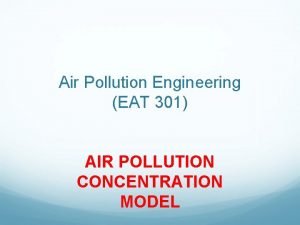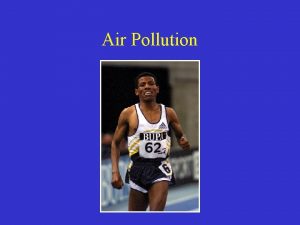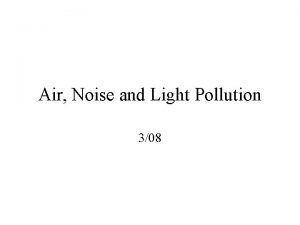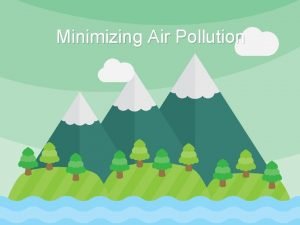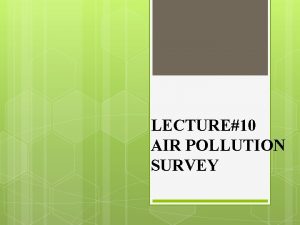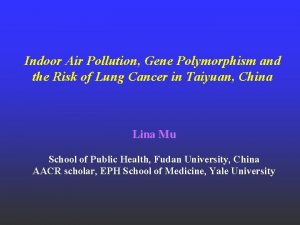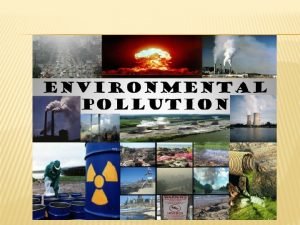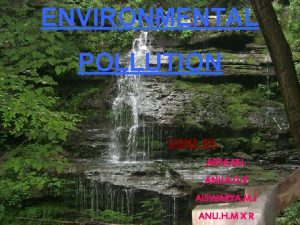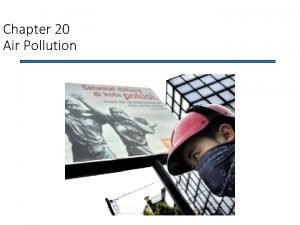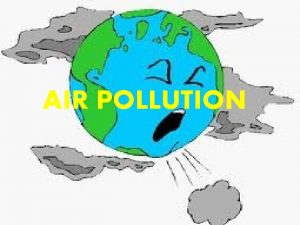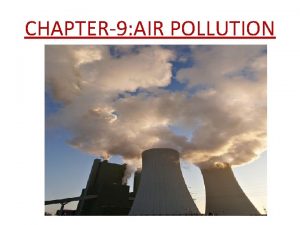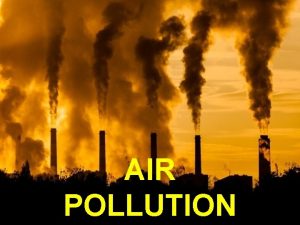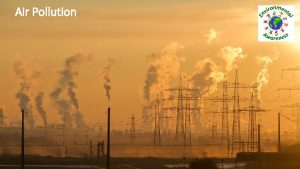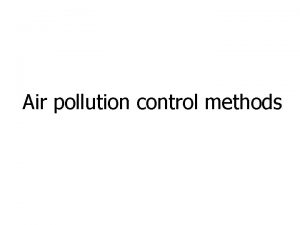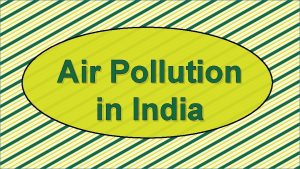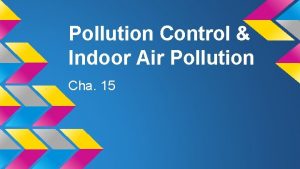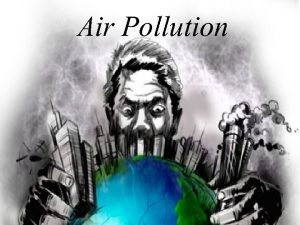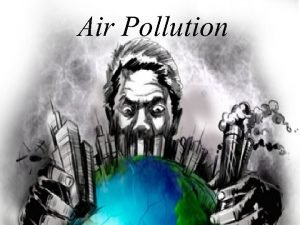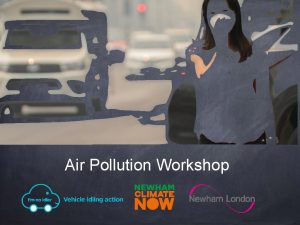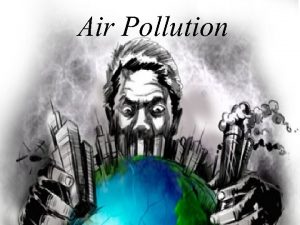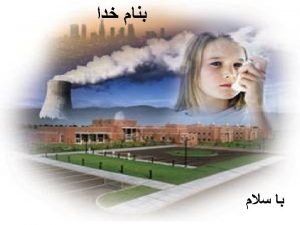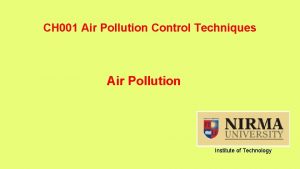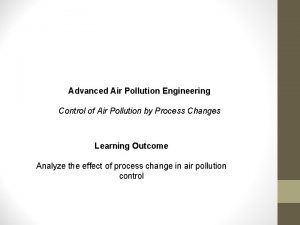Industrial air pollution control Regulatory Importance in India



































- Slides: 35

Industrial air pollution control Regulatory Importance in India Dr. Sanjeev Agrawal, Senior Scientist Pollution Assessment Monitoring and Survey Division Central Pollution Control Board Ministry of Environment & Forests Parivesh Bhavan, East Arjun Nagar Delhi – 110032 Dept of Environment GNCTD New Delhi, 4 th April, 2016

Air Pollution Pure air: 78. 09% Nitrogen, 20. 95% Oxygen, 0. 93% Argon, 0. 039% carbon dioxide, and rest other gases. Air pollutant: Any solid, liquid or gaseous substance present in the atmosphere in such concentration as may be or tend to be injurious to human beings or other living creatures or plants or property or environment is known as air pollutant. As per Section 2(a) of Air (Prevention and control of pollution) Act, 1981 Air pollution: ‘the presence of any pollutant in the atmosphere is known as air pollution. Section 2(b) of Air (Prevention and control of pollution) Act, 1981

Air pollutants – sources & effects Pollutant Anthropogenic sources Effects on human health SO 2 Combustion of fossil fuel Respiratory disorder, visibility impairment NO 2 Biomass & fossil fuel burning Respiratory disorder CO Exhaust of internal combustion engines Respiratory disorder. Anomexis, Cardiovascular problems NH 3 Fertilizer industry Respiratory disorder, skin & eye irritation O 3 Reaction of sunlight on air containing hydrocarbons and NOx Respiratory disorder, Cardiovascular problems Pb Automobile exhaust, Cosmetics, firewood burning, tobacco, batteries. Waste incineration, Metal processing, Paint, Effects on CNS, cardiovascular system, kidneys, immune system, miscarriage & reduction of fertility Ni Combustion of fossil fuels, Nickel plating, Metallurgical processes Allergy, dermatitis As Combustion of fuels, Smelting of metals, glass prodction, Multi-system organ failure, poisoning, epigenetic changes,

Air pollutants: sources & effects contd… Pollutants Anthropogenic sources Effects on human health C 6 H 6 Combustion of fossil fuel Reproductive effects, Neurotoxic, Hematotoxic, leukemogenic, carcinogenic, PAH Incomplete combustion of fuels Respiratory disorder, mutagenic, carcinogenic effects PM 10 Vehicular emission, Road traffic emissions, industrial combustion, agricultural burning Respiratory disorder, Cardiovascular problems PM 2. 5 Vehicular emission, Industrial & residential combustion, Biomass burning, thermal power plants Respiratory disorder, Cardiovascular problems , Oxidative stress, Systemic & immune alterations , Genotoxicity Neurotoxicity, Reprotoxicity Pollutants as on the revised National Ambient Air Quality Standards, 2009 Health effects are the impact of a complex mixture rather than a particular pollutant

Air (Prevention & Control of Pollution) Act, 1981 Government of India enacted the Air (Prevention and Control of Pollution) Act 1981 to arrest the deterioration in the air quality. Main Function of CPCB under Air (Prevention and Control of Pollution) Act 1981: § To advise the Central Government on any matter concerning the Improvement of the quality of the air and the prevention, control and abatement of air pollution. § To plan and cause to be executed a nation-wide programme for the prevention, control and abatement of air pollution. § To provide technical assistance and guidance to the State Pollution Control Board. § To carry out and sponsor investigations and research related to prevention, control and abatement of air pollution. § To collect, compile and publish technical and statistical data related to air pollution; and § To lay down standards for the quality of air.

Regulation of Air Pollution There are two important statutes, which regulate the air pollution in India i. e. Air (Prevention and Control) Act, 1981 (Air Act) and Environment (Protection) Act, 1986 (EPA). The Air Act provides a mandatory consent (permit) from SPCB for establishing (consent to establish) and operating (consent to operate) any industry. The pollution control boards have the authority to issue and revoke consents to operate, require self-monitoring and reporting, conduct sampling, inspect facilities, require corrective action and prescribe compliance schedules. The enforcement powers include emergency measures of disconnecting water or power supply and facility closure, which are widely used in some states. Other sanctions (fines and imprisonment) are being pursued under the criminal authority of the courts, which consume lots of time and resources and have very low conviction rate.

Important consent provisions of Air Act, 1981 Apply for the renewal of “Consent to Operate” before expiry of the validity period; Consent to be deemed as granted after four months from the date of receipt of application if no communication from the SPCB is received; A prior “Notice of Inspection” to be served by the SPCB; Industry to ensure that specified emission sampling procedure is being followed by the SPCB; Opportunity to file objections with the SPCB within 15 days from the date of service of notice; PCB to record reasons in writing in case it does not provide an opportunity to the industry to file objections.

Air (Prevention and Control of Pollution) Act, 1981 Chapter 1 Section 1 -2 Title and definitions Chapter 2 Section 3 -15 Chapter 3 Section 16 -18 Constitution of Central and State Bds Powers and Functions of the CPCB and SPCBs Chapter 4 19 -31 Control of Pollution SPCB declare air polln contl area, Power to give instr to Tr Auth, Consent for air pollution, Restriction on emission beyond stds, Power to prosecute, Power to entry, obtain information, take samples, State Air Lab and analyst, report and Appeal, power to give directions Chapter 5 Section 32 -36 Funds & Accounts Chapter 6 Section 37 -41 Penal Provisions Failure to comply Sect 21, 22 & 31 A – 1 yr imprisonment extendable to 6 yrs with fine, which could be Rs 5000/day of contravention Chapter 7 Miscellaneous Power to supersede SPCB

Salient Features of Environment (Protection) Act, 1986 Comply with the directions issued by the Central Government. The direction may include: closure, prohibition or regulation of any industry, or stoppage or regulation of the supply of electricity, water or any other service Prevent discharges or emissions excess of the prescribed standards Furnish information of any accidental or unforeseen event Allow entry and inspection to ascertain compliance Allow samples to be taken Submit an “Environmental Statement” every year before 30 th September to the SPCB Obtain prior “Environmental Clearances” from Mo. EF, in case of a new project or for modernization/expansion of the existing project

Regulation of Air Pollution Under EPA, the industry needs environmental clearance (EC) before establishment from the Ministry of Environment and Forests, Govt of India or State Pollution Control Board depending on the type and size of the industry, which needs detailed environmental appraisal and an environment management plan. Based on satisfactory appraisal of the impact assessment and environment management plan the EC is granted, which ensure that suitable provisions for protecting environment have been made. It requires detailed environmental impact assessment study. The basic objective of Environmental Impact Assessment (EIA) is to identify, predict and evaluate the likely economic, environmental and social impact of any developmental activities and to prepare an action plan for remedies as a part of the overall Environmental Management Plan (EMP). These plans are implemented during operational phase and compliance of the consent conditions and EC conditions are regularly monitored by the concerned SPCBs.

Need for Ambient Air Quality Monitoring in Pollution Prevention and Control of Air Pollution under the Regulatory Framework AAQM- need Under the Air Act, 1981 &Environment (Protection) Act, 1986 Consent procedure Environmental Clearance Procedure In setting Emission Standards To generate Ambient Air Quality Trends To prepare Environmental Management Plan (EMP) To perform Environmental Impact Assessment (EIA) To prepare Environmental Statement Preparing Minimal National Standards (MINAS) Compliance check of Air Pollutants at different sources

Overview of approach to air pollution control in India

Who needs consent? Section 21(1) of The Air (Prevention and Control Of Pollution) Act, 1981 [Subjects to the provisions of this section, no person shall, without the previous consent of the State Board, establish or operate any industrial plant in an air pollution control area: Provided that a person operating any industrial plant in any air pollution control area, immediately before the commencement of section 9 of the Air (Prevention and Control Of Pollution) Amendment Act, 1987, (47 of 1987) for which no consent was necessary prior to such commencement, may continue to do so for a period of three months from such commencement or, if he has made an application for such consent within the said period of three months, till the disposal of such application Thus, it leads two questions such as: ØAir Pollution Control Area ØEmission of air pollutants

Definition of Air Pollutants Under section 2(a) The Air (Prevention and Control Of Pollution) Act, 1981 (a)“air pollutant” means any solid, liquid or gaseous substance [)including)] present in the atmosphere in such concentration as may be or tend to be injurious to human beings or other living creatures or plants or property or environment; (b)“air pollution” means the presence in the atmosphere of any air pollutant;

Declaration of Air Pollution Control Area Under Section 19 (1) of the Air Act, State Govt. has been empowered to declare any area or areas within the state as air pollution control area or areas for the purpose of this act. State govt. under section 19 (3) can prohibit the use of any fuel, other than an approved fuel, in any air pollution control area or part thereof may cause or is likely to cause air pollution. Under section 19 (5) state Govt. also can prohibit that the burning of any material other than fuel in any of the air pollution control area.

Application for Consent Industries us 21(2) shall apply to state pollution control board in the prescribed form State Board shall within four months after the receipt of the application for consent either grant the consent applied for or refuse the consent;

Condition for granting Consent Section 21(5) of the Air Act laid down the consent condition as follow: Every person to whom consent has been granted by the State Board under sub section (4), shall comply with the following conditions, namely(i) the control equipment of such specifications as the State Board may approve in this behalf shall be installed and operated innthe premices where the industry is carried on or proposed to be carried on; (ii) The existing control equipment, if any, shall be altered or replaced in accordance with the directions of the State Board; (iii) The control equipment refered to in clause (i) or clause (ii) shall be kept at all times in good running condition; (iv) Chimney, wherever necessary, of such specifications as the State Board may approve in this behalf shall be erected or re-erected in such premices; (v) Such other conditions as the State Board, may specify in this behalf; and (vi) Provided that in the case of a person operating any industrial plant in air pollution control area immediately before the date of declaration of such area as in air pollution control area, the period to specified shall not be less than six months: (vii) Provided further that(a) After the installation of any control equipment in accordance with the (b) (c) specifications under clause (i), or After the alteration or replacement of any control equipment in accordance with the directions of the State Board under clause (ii), or After the erection or re-erection of any chimney under clause (iv), no control equi[pment or chimney shall be altered or replaced or, as the case may be, erected or re-erected except with the previous approval of State Board

Developments of Standards Under Section 17(1)(g) state board is asked “to lay down, in Consultation with the Central Board and having regard to the standards for the quality of air laid down by the Central Board, standards for emission of air pollutants inti the atmosphere from industrial plants and automobiles or for the discharge of any air pollutant into the atmosphere from any other source whatsoever not being a ship or an aircraft; Provided that different standards for emission may be laid down under this clause for different industrial plants having regard to the quantity and composition of emissionof air pollutant into the atmosphere from such industrial plants;

Ambient Air Quality Standards Under section 16 (2)(h) CPCB is asked to lay down standards for the quality of air In particular and without prejudice to the generality of the foregoing functions, the Central Board may lay down standards for the air quality of air

List of emission standards notified under EPA Act ØThermal power plants The Environment (Protection) Rules, 1986 ØPetroleum oil refinery ØSugar industry ØElectroplating industries ØCement plant ØCoke ovens ØStone crushing unit ØFertilizer industry ØLeather industries ØCopper, lead and zinc smelting ØSulphuric acid pant ØIron & steel ØAsbestos manufacturing unit ØPetrochemicals ØPesticide manufacturing and formulation industry ØTannery ØCeramic industry

Implementation of Standards ØSection 22 A: power of the board to make application to court for restraining persons from causing air pollution ØSection 24: Power of entry and inspection ØSection 25: Power to obtained information ØSection 26: Power to take samples of air emission and procedure to be followed in connection therewith ØSection 31 A: Power to give direction

Penalties and Procedure ØSection 37: Failure to comply with the provisions of section 21 or section 22 or with the directions issued under section 31 A ØSection 38: Penalties for certain acts ØSection 39: Penalty for contravantion of certain provisions of the act ØSection 40: Offences by companies ØSection 41: Offences by Government department

Penalties for violation of various provisions under the Air Act, 1981 üSection 37. Failure to comply with the provisions of section 21 or section 22 or with the directions issued under section 31 -A. üSection 38. Penalties for certain acts üSection 39. Penalty for contravention of certain provisions of the Act. üSection 40. Offences by companies üSection 41. Offences by Government departments

Important provisions under Air Act Key Aspects Related Section of Air Act, 1981 Constitution of Board 1 -17 Power to give directions 18 Declaration of Air Pollution Control Area 19 Power to obtain information 20 and 25 Mandatory Consent From SPCB 21 Imposing emission standards 22 Power to prosecute 22 A Power to enter and inspect 24 Power to obtain information and take samples 25, 26 State Air Lab, Analyst and Report 28, 29, 30 Appeal 31 Power to give directions 31 A Penal provisions for violation of provisions of the Act 37 -41 Section 21, 22, 31 A

Important provisions of Environment (Protection) Act, 1986 Key Aspects Objectives Creating Authority Power to Issue Directions Rules to regulate environmental pollution Related Section of Air Act, 1981 1 3 5 6 7 Restrictions on emission or discharge of environmental pollutants in excess of the standards Furnishing of information in certain cases 9 Power of search and entry 10 Power to take samples 11 Environmental laboratories 12 Evidence 14 Penal provision 15 Offence by a company 16 Offence by Government department 17 Protection of action done in good faith 18 Cognizance of offences (citizen's suit) 19 Information reports or returns 20 21 Members, officers and employees of the authority constituted under Section 3 to be public servants 23 Powers to delegate

Overview of approach to air pollution control in India

Summary of regulations related to air pollution control Year Policy/Program/Act Notification etc. Coordinating Agency 1976 Govt of India Constitution of India, Article 48, 51 -A 1981 Air (Prevention and Control of Pollution) Act 1982 Air (Prevention and CPCB, SPCBs Control of Pollution) Rules Environment (Protection) Act Mo. EF, 1986(EPA) followed by 1986, 1994 CPCB, SPCBs amendment in May 1994 (Schedule-I) 1987 The Environment Highlights Article 48 -A and Article 51 -A (g) of the Constitution of India are the basic principles to safeguard the environment. Article 48 states that “the state shall endeavor to protect and improve the environment to safeguard the forests and wildlife of the country”. Article 51 -A (g) on Fundamental Duties emphasizes that “It shall be the duty of every citizen of India to protect and improve the natural environment including forest, lakes, rivers and wild life to have compassion for living creatures”. Provides means for the control and abatement of air pollution. The Air Act vests the regulatory authority on pollution control boards and empowers them to enforce emission standards to control the air pollution. Section 21 of the Act requires making an application to the state PCB to establish or operate any industrial operation. Defined the procedures for conducting meetings of the boards, the powers of the presiding officers, decision-making etc Ensure that appropriate measures are taken to conserve and protect the environment before commencement of operations. The EP Act is an umbrella legislation and supplements the existing environmental regulations, the Water Act and the Air Act. As per the Act, “Central Government shall have the power to take all such measures as it deems necessary or expedient for purpose of protecting and improving the quality of environment and preventing, controlling and abating environmental pollution”. The Act empowers the regulatory authority to “restriction of areas in which any industries, operations or processes or class of industries shall not be carried out or shall be carried out subject to certain safe guards”. Lay down the procedures for setting standards of emission or discharge of environmental pollutants. Mo. EF (Protection) Rules 1989 1992 The Hazardous Wastes Mo. EF Management (M. & H. ) Rules Pollution Abatement Policy Mo. EF 1992 Conservation policy Mo. EF 1994 Environmental Impact Assessment Notification Mo. EF, SPCBs Identifies the project categories that need environmental clearance from the Central Government in form of an approved Environmental Impact Assessment (EIA) 1995 National Environment Tribunal Act Notification for use of beneficial coal Notification for use of flyash Mo. EF To provide for strict liability for damages arising out of any accident occurring while handling any hazardous substance 1997 1999 2001 2006 Energy Conservation Act National Environment Policy Mo. EF, SPCBs Providing for making effective procedure for inventory, control, handling and disposal of hazardous waste. provide for setting up of disposal sites/landfill sites design, operation and closure. CPCB, Mandated the use of beneficial/blended coal with ash not of not more than 34% from June 2001 in power plants located beyond 1000 km from pitheads and those located in critically polluted areas, urban areas and ecologically sensitive areas CPCB, To discourage the dumping of ash and promote its utilization, Power plants required preparing an action plan for full utilization of fly ash, and providing ash free of cost (for at least ten years) for the purpose of manufacturing ash-based products. Brick manufacturing within a radius of 50 km from coal or lignite based power plants to use at least 25 percent of ash with soil on weight-to-weight basis. Local authorities required to specify in their respective building bylaws and regulations the use of ash and ash-based products. Ministry of Power Enables the creation of the Bureau of Energy Efficiency which would recommend energy consumption norms and standards, create awareness, disseminate information for efficient use of energy and its conservation, promote R&D in energy conservation, provide Mo. EF financial assistance to institutions to promote energy efficiency, implement international cooperation programs relating to energy efficiency etc. Conservation of critical environmental resources, livelihood security for poor, integration of environment concerns in economic and social development, maintaining efficiency in environmental resources use, seeking good governance in management and use of environmental resources and enhancement of resources for environmental conservation

Way forward The road map at the earliest for next stage of norms i. e. BSV/BSVI ØAs technology is available both for refineries and auto manufacturers to even leapfrog to BS VI, cost factors need to be fixed through fiscal policy interventions/incentives. ØTax Incentives for voluntary compliance to BSV emission levels with BS IV i. e. 50 ppm fuel with effect from April 20017 and for BS VI compliance with 10 ppm fuel from April 2020 may be offered to automobile manufacturers. ØGlobal experience for retrofit options need to be made use of once 50 ppm fuel is available allover the country to reduce emissions to the extent possible from in use LDV/HDVs. ØSuitable measures for on road emission testing/compliance by the in- use vehicles need to be implemented without any delay. (Beijing Example may be considered). ØFuel efficiency norms need to be in line with best global practice. ØClean fuels like Bio-fuels, CNG and Hydrogen need to be encouraged.

THANK YOU

NATIONAL AMBIENT AIR QUALITY STANDARDS (Notified on 18 th November, 2009) CPCB is asked to lay down standards for the quality of air under section 16(2)(h) S. No. Concentration in Ambient Air Industrial, Ecologically Residential, Sensitive Area Rural and (notified by other Areas Central Govt) 50 20 80 80 40 30 80 80 60 60 100 Methods of Measurement Pollutants Time Weighted Average Dioxide (SO 2), µg/m 3 Nitrogen Dioxide (NO 2 ), µg/m 3 Particulate Matter (Size <10µm) or PM 10 µg/m 3 Annual* 24 Hours** 4 Particulate Matter (Size <2. 5 µm) or PM 2. 5 µg/m 3 Annual* 24 Hours ** 40 60 5 Ozone (O 3), µg/m 3 8 hours** 1 hours ** 100 180 6 Lead (Pb), µg/m 3 Annual * 24 Hour** 0. 50 1. 0 7 Carbon Monoxide (CO), mg/m 3 8 Ammonia (NH 3), µg/m 3 9 Benzene (C 6 H 6) , µg/m 3 8 Hours ** 1 Hour** Annual* 24 Hour** Annual * 02 04 100 400 05 10 Annual* 01 01 Solvent extraction followed by HPLC/GC analysis 11 Benzo(a)Pyrene (Ba. P)particulate phase only, ng/m 3 Arsenic (As), ng/m 3 Annual* 06 06 12 Nickel (Ni), ng/m 3 Annual* 20 20 AAS/ICP method after sampling on EPM 2000 or equivalent filter paper 1 2 3 1. Improved West and Gaeke 2. Ultraviolet Fluorescence 1. Modified Jacob & Hochheiser (Na-Arsenite) 2. Chemiluminescence 1. Gravimetric 2. TOEM 3. Beta attenuation 1. UV photometric 2. Chemiluminescence 3. Chemical Method 1. AAS/ICP Method after sampling using EPM 2000 or equivalent filter paper 2. ED-XRF using Teflon filter Non dispersive Infra Red (NDIR) Spectroscopy 1. 2. Chemiluminescence Indophernol blue method Gas chromatography based continuous analyzer Adsorption and Desorption followed by GC analysis * Annual Arithmetic mean of minimum 104 measurements in a year at a particular site taken twice a week 24 hourly at uniform interval. ** 24 hourly 08 hourly or 01 hourly monitored values, as applicable shall be complied with 98% of the time in a year. 2% of the time, they may exceed the limits but not on two consecutive days of monitoring. NOTE: Whenever and wherever monitoring results on two consecutives days of monitoring exceed the limits specified above for the respective category, it shall be considered adequate reason to institute regular or continuous monitoring and further investigation.

National Environment Policy 2006 To plan for the people rather than vehicles by providing sustainable mobility and accessibility to all citizens to jobs, education, social service and recreation at affordable cost and within reasonable time. REALIZING POLICY OBJECTIVES The objectives of this policy would be achieved through comprehensive approach include Urban Transport Planning, Infrastructure Design, Public Transport, Non-Motorized Transport, Traffic Management, Financing, Governance and Capacity Building Ø URBAN TRANSPORT PLANNING Ø INFRASTRUCTURE Ø PUBLIC TRANSPORT Ø NON-MOTORIZED TRANSPORT (NMT) Ø TRAFFIC MANAGEMENT Ø FINANCING Ø GOVERNANCE Ø CAPACITY BUILDING Ø NEED FOR PUBLIC AWARENESS AND COOPERATION National Urban Transport Policy 2014 A response to India’s national commitment to a clean environment, ü Mandated in the Constitution in Articles 48 A and 51 A (g), strengthened by judicial interpretation of Article 21 ü Recognized that the maintenance of the Healthy environment is not the responsibility of the state alone. It is the responsibility of every Citizen and thus a spirit of partnership is to be realized through the environment management of the country. Polluter Pays” principle Impacts of production and consumption of one party may be visited on third parties who do not have a direct economic nexus with the original act. Such impacts are termed “externalities”. The National Environment Policy promotes the internalization of environmental costs, including through the use of incentives based policy instruments, taking into account the approach that the polluter should, in principle, bear the cost of pollution, with due regard to the public interest, and without distorting international trade and investment.

Auto Fuel Policy in India: Key Issues • Auto Fuel Policy 2002 laid down a roadmap for introduction of cleaner fuels and vehicles in the country upto 2010. • Based on the roadmap, 13 selected cities were moved to BS-IV norms by 2010, while rest of the country is still on BS-III norms. Therefore, there exists one set of NAAQS and dual standards for vehicle emission and fuel quality. • The rate of increase in RSPM concentrations is much higher in cities where lower quality fuel is provided • Heavy-duty trucks still remain on BS-III standards all across the country, although they are registered in cities where BSIV norms have been introduced. • When BS-IV compliant vehicles move out of the cities where BS-IV fuel is available, they have to use inferior quality fuel and that could choke their engines • Auto Fuel Vision Committee was set up in 2013 to recommend the future roadmap on advancement of fuel quality and vehicular emission standards upto 2025. The committee has recommended the introduction of BS-IV and BS-V norms across the country by 2017 and 2020, respectively. BS-VI emission norms are recommended to be introduced by 2024. • The roadmap recommended by the Auto Fuel Vision 2025 Committee puts India 10 years behind the US and European countries.

National Industrial Policy Industrial policy is a statement which defines the role of government in industrial development Objectives (i) Rapid Industrial Development: aimed at increasing the tempo of industrial development (ii) Balanced industrial Structure: imbalances in the industrial structure by laying emphasis on heavy industries and development of capital goods sector, industrial policy seeks to bring a balance in industrial structure. (iii) Prevention of Concentration of Economic Power: provide a framework of rules, regulations and reservation of spheres of activity for the public and the private sectors. To reducing the monopolistic (iv) Balanced Regional Growth: The Industrial policy of 1948, which was the first industrial policy statement of the Government of India, was changed in 1956 in a public sector dominated industrial development policy that remained in force till 1991 with some minor modifications and amendments in 1977 and 1980. In 1991, far reaching changes were made in the 1956 industrial policy. The new Industrial Policy of July 1991 heralded the framework for industrial development at present.

National Agriculture Policy 2014 salient features Ø Over 4 per cent annual growth rate aimed over next two decades. . Ø Greater private sector participation through contract farming. Ø Price protection for farmers. Ø National agricultural insurance scheme to be launched. Ø Dismantling of restrictions on movement of agricultural commodities throughout the country. Ø Rational utilisation of country's water resources for optimum use of irrigation potential. Ø High priority to development of animal husbandry, poultry, dairy and aquaculture. Ø Capital inflow and assured markets for crop production. Ø Exemption from payment of capital gains tax on compulsory acquisition of agricultural land. Ø Minimise fluctuations in commodity prices. Ø Continuous monitoring of international prices. Ø Plant varieties to be protected through a legislation. Ø Adequate and timely supply of quality inputs to farmers. Ø High priority to rural electrification. Ø Setting up of agro-processing units and creation of off-farm employment in rural areas. Ø Sustainable Agriculture - Sensitization of the farming community with the environmental concerns will receive high priority. Balanced and conjunctive use of bio-mass, organic and inorganic fertilizers and controlled use of agro chemicals through integrated nutrients and pest management (INM & IPM) will be promoted to achieve the sustainable increases in agricultural production. A nation-wide programme for utilization of rural and urban garbage, farm residues and organic waste for organic matter repletion and pollution control will be worked out.

Environmental Laws in India
 Slogan on air pollution
Slogan on air pollution Chapter 12 section 1 what causes air pollution answers key
Chapter 12 section 1 what causes air pollution answers key Chapter 12 air section 1 what causes air pollution
Chapter 12 air section 1 what causes air pollution Erg (air pollution control) ltd
Erg (air pollution control) ltd Air pollution box model example
Air pollution box model example Northern sonoma county air pollution control district
Northern sonoma county air pollution control district Air pollution control methods
Air pollution control methods Air pollution control technology
Air pollution control technology Regulatory framework for financial services in india
Regulatory framework for financial services in india Legal and regulatory framework of microfinance in india
Legal and regulatory framework of microfinance in india Regulatory framework of money market in india
Regulatory framework of money market in india Regulatory impact assessment india
Regulatory impact assessment india Hubungan air tanah dan tanaman
Hubungan air tanah dan tanaman Missile launcher control system
Missile launcher control system Industrial policy resolution in india
Industrial policy resolution in india Emerging challenges of industrial relations in india
Emerging challenges of industrial relations in india Relations
Relations Soil pollution effects on human health
Soil pollution effects on human health 8 effects of water pollution
8 effects of water pollution Land water and air pollution
Land water and air pollution Introduction of pollution
Introduction of pollution Air pollution effect on plant
Air pollution effect on plant Contents of air pollution
Contents of air pollution Air pollution aims and objectives
Air pollution aims and objectives Main cause of air pollution
Main cause of air pollution Air pollutants primary and secondary
Air pollutants primary and secondary Stationary and mobile sources of air pollution
Stationary and mobile sources of air pollution Air pollution box model example
Air pollution box model example General effects of air pollution
General effects of air pollution Air pollution consequences
Air pollution consequences Air pollution
Air pollution Objectives of air pollution
Objectives of air pollution Air pollution
Air pollution Air pollution class 9
Air pollution class 9 Air pollution intro
Air pollution intro Two sources of air pollution
Two sources of air pollution
